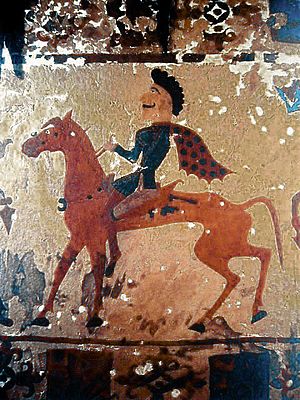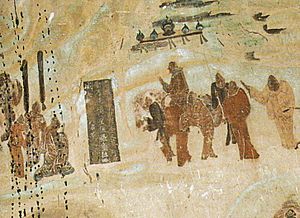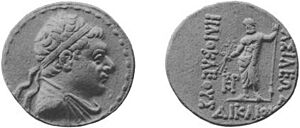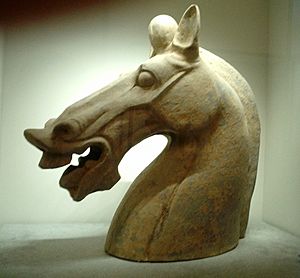Dayuan facts for kids

Dayuan (also called Tayuan) was the Chinese name for a country in Central Asia. It was located in the Ferghana Valley, which is now part of countries like Tajikistan, Uzbekistan, and Kyrgyzstan. Chinese historical books like Records of the Grand Historian and Book of Han describe Dayuan.
The Chinese explorer Zhang Qian first wrote about Dayuan around 130 BCE. Many Chinese groups visited the area after him. People believe Dayuan was linked to the Greek city of Alexandria Eschate (modern Khujand, Tajikistan). This city was founded by Alexander the Great. The name "Dayuan" likely meant "Great Ionians" or "Great Greeks."
Chinese records say the people of Dayuan lived in cities with walls. They looked like Europeans and had customs similar to the Greco-Bactrians. The Greco-Bactrians were a Greek kingdom in what is now northern Afghanistan. The Dayuan people were also known for making things and loving wine.
The Dayuan people were descendants of Greeks. Some were forced to move there by the Persian Empire. Others were Greek settlers brought by Alexander the Great in 329 BCE. They thrived under the Greek kingdoms of the Seleucids and Greco-Bactrians. But they became cut off when the Yuezhi people moved through the area around 160 BCE, followed by the Scythians in 140 BCE.
Around 100 BCE, the Han dynasty of China attacked and defeated Dayuan in the Han-Dayuan war. This event was very important. It was one of the first big meetings between an advanced civilization in Central Asia and the Chinese. This meeting helped create the Silk Road. The Silk Road was a famous trade route that connected the East and West for centuries. It allowed goods and ideas to be exchanged from the 1st century BCE to the 15th century CE.
Contents
History of Dayuan
Early Greek Influence
This region was once ruled by the Persian Empire, starting with Xerxes I. Greeks began living there around this time. If Greeks in other parts of the Persian Empire caused trouble, they were sometimes sent to Sogdia. This was a far-off region in the northeast of the empire. The biggest city there was called Cyropolis by the Greeks. By the time Alexander the Great conquered Persia, Greek villages, language, and culture were common in this area.
Greek Rule (329–160 BCE)

Alexander the Great conquered the Ferghana region in 329 BCE. It became his most distant base in Central Asia. He founded a fortified city called Alexandria Eschate (meaning "Alexandria the Furthest"). He likely built it on the site of Cyropolis. This city was in the southwestern part of the Ferghana valley, near the Syr Darya river. Today, it's the city of Khujand in Tajikistan. Alexander built a long brick wall around the city. He also settled retired soldiers and wounded veterans there.
The entire region, including Ferghana, was controlled by the Greek Seleucid Empire until 250 BCE. Then, the Greek governors, led by Diodotus of Bactria, broke away. They formed their own independent state, the Greco-Bactrian Kingdom.
Greco-Bactrian Kingdom (250–160 BCE)
The Greco-Bactrians kept control of their land. The Greek historian Strabo wrote that they even went beyond Alexandria Eschate. They "extended their empire as far as the Serica" (China). There are signs that they might have explored as far as Kashgar in Xinjiang, China. This could mean the first known contacts between China and the West happened around 200 BCE. Statues and pictures of Greek soldiers have been found north of the Tien Shan mountains. They are now in the museum of Urumqi.
Around 160 BCE, Saka tribes (called Sai-Wang by the Chinese) seem to have invaded Ferghana. The Sai-Wang originally lived near Lake Issyk Kul. They were moving south because the Yuezhi people had pushed them out. The Yuezhi themselves were running from the Xiongnu people.
The Chinese book Han Shu says:
The Yuezhi attacked the king of the Sai ("Sai-Wang") who moved a considerable distance to the south and the Yuezhi then occupied his lands.
The Sakas took over the Greek land of Dayuan. This happened because the Greco-Bactrians were busy fighting in India against the Indo-Greeks. They couldn't defend their northern areas well. Historian W. W. Tarn wrote that it was easy for the Sakas to take Ferghana. This was because King Eucratides had just taken over the Greek kingdom. He was also in India with his army and died in 159 BCE. His successor, Heliocles, was too busy with other conflicts to protect this distant area.
Saka Rule

The Sakas likely began ruling Dayuan around 160 BCE. When the Chinese explorer Zhang Qian described Dayuan around 128 BCE, he mentioned a thriving civilization. He also saw warriors "shooting arrows on horseback." This probably describes the nomadic horse archers common among the Eurasian nomads like the Sakas. By then, Dayuan had probably become a kingdom ruled by a militaristic Saka class. They likely collected taxes and tributes from the local Greek population.
From 106–101 BCE, during their war with China, Dayuan was an ally of the nearby Kangju tribes (likely the Sogdians). The Chinese also recorded the name of Dayuan's king as "Mu-Kua." This was a Saka name, possibly like Mauakes or Maues in Greek. Another Scythian ruler named Maues later ruled the Indo-Scythian kingdom in northern India.
Yuezhi Migration
According to Chinese records, in 132 BCE, the Wusun people drove the Yuezhi out of the Ili River valley. The Yuezhi fled south, passing by the cities of Dayuan in Ferghana. They settled north of the Oxus River in Bactria. This movement completely cut off Dayuan from the Greco-Bactrian kingdom. The Yuezhi later expanded further south into Bactria around 125 BCE. They eventually formed the powerful Kushan Empire in the 1st century CE.
Han Chinese Rule and Interaction
Dayuan remained a strong civilization. It had many contacts and traded with China starting from 130 BCE.
Zhang Qian's Report

Around 130 BCE, when Zhang Qian visited Central Asia, he described Dayuan. He said it was a region far west of the Chinese empire, matching the Ferghana area.
The Chinese book Han Shu states:
The capital of the kingdom of Dayuan is the city of Guishan (Khujand). The kingdom contains 60,000 families, with a population of 300,000, and 60,000 trained troops.
To the southwest of Dayuan were the lands of the Yuezhi. The Greco-Bactrians were even further south, beyond the Oxus River.
The Shiji (another Chinese historical record) explains:
The Shiji also says that the Yuezhi first lived in the Hexi Corridor in China. But they were defeated by the Xiongnu in 176 BCE. This forced them to move west, past Dayuan, and settle near the Oxus River.
City Life and Culture

Zhang Qian said that the customs of the Dayuan people were the same as those of the Bactrians. The Bactrians were part of the Greco-Bactrian Kingdom at that time.
The Shiji describes them:
Their customs (the Bactrians) are the same as those of Dayuan. The people have fixed abodes and live in walled cities and regular houses like the people of Dayuan. They have no great kings or heads, but everywhere in their walled cities and settlements they have installed small kings.
They were described as people who lived in towns, unlike the nomadic Yuezhi, Wusun, or Xiongnu.
The Han Shu adds:
They have walled cities and houses; the large and small cities belonging to them, fully seventy in number, contain an aggregate population of several hundreds of thousands…There are more than seventy other cities in the country.
Appearance and Habits
The Shiji also talks about the appearance and culture of the people around Dayuan:
Although the states from Dayuan west to Anxi speak rather different languages, their customs are generally similar and their languages mutually intelligible. The men all have deep-set eyes and profuse beards and whiskers. They are skillful at commerce and will haggle over a fraction of a cent. Women are held in great respect, and the men make decisions on the advice of their women.
They were skilled makers of goods and loved wine:
Round about Dayuan they make wine from grapes. Wealthy people store up as much as 10,000 stones and over in their cellars, and keep it for several tens of years without spoiling. The people are fond of wine.
After Zhang Qian's visit, grapes and alfalfa were brought to China from Dayuan. The Shiji says:
The regions around Dayuan make wine out of grapes... The Han envoys brought back grape and alfalfa seeds to China and the emperor for the first time tried growing these plants in areas of rich soil.
The Shiji also claims that metal casting was taught to the Dayuan region by Chinese soldiers who ran away:
... the casting of coins and vessels was formerly unknown. Later, however, when some of the Chinese soldiers attached to the Han embassies ran away and surrendered to the people of the area, they taught them how to cast metal and manufacture weapons.
Han-Dayuan War
After Zhang Qian's reports, the Chinese emperor Wudi became interested in trading with the advanced cities of Ferghana, Bactria, and Parthia. The Shiji says the emperor thought:
Ferghana (Dayuan) and the possessions of Bactria and Parthia are large countries, full of rare things, with a population living in fixed abodes and given to occupations somewhat identical with those of the Chinese people, but with weak armies, and placing great value on the rich produce of China.
China then sent many groups of ambassadors, about ten each year, to these countries. They even went as far as Seleucid Syria.

The Chinese were also very interested in the tall, strong horses ("heavenly horses") owned by the Dayuan. These horses were very important for fighting the nomadic Xiongnu. But Dayuan refused to give enough horses to the Chinese. This led to conflicts and disrespect. A Chinese ambassador was killed, and gold sent for payment was taken.
Emperor Wudi was angry. He thought Dayuan was weak. So, in 104 BCE, he sent his general Li Guangli with 6,000 horsemen and 30,000 young men. General Li lost many men fighting local rulers along the way. After a defeat at a place called Yucheng, Li realized he wasn't strong enough. He returned to Dunhuang around 102 BCE.
Emperor Wudi then gave Li Guangli a much bigger army. He also provided many oxen, donkeys, and camels to carry supplies. With this new force, Li easily reached Ershi, the capital of Dayuan. After a 40-day siege, the Chinese broke through the outer wall and cut off the water supply. The nobles of Ershi killed their king and sent his head to Li Guangli. They offered the Chinese all the horses they wanted. Li accepted, chose one of the nobles to be the new king, and left with the horses. On his way back, all the small states accepted Chinese rule. He reached the Jade Gate around 100 BCE with 10,000 men and 1,000 horses.
After this peace treaty, China re-established contact with the West. Ambassadors were sent again, and trade caravans traveled to Bactria.
East-West Trade and Cultural Exchange
The Silk Road truly began in the 1st century BCE. This was thanks to China's efforts to create a route to the Western world. They did this by settling in the Tarim Basin and forming diplomatic ties with Dayuan, Parthians, and Bactrians further west.
Soon, intense trade followed. The Romans became very fond of Chinese silk, which they got from the Parthians. This was so much that the Roman Senate even tried to ban wearing silk, but it didn't work. Famous Roman writers like Strabo, Seneca the Younger, and Pliny the Elder wrote about this trade.
This was also the time when the Buddhist faith and Greco-Buddhist culture began to spread along the Silk Road. Buddhism entered China from around the 1st century BCE.
See also
- History of Buddhism
- Greco-Buddhism



